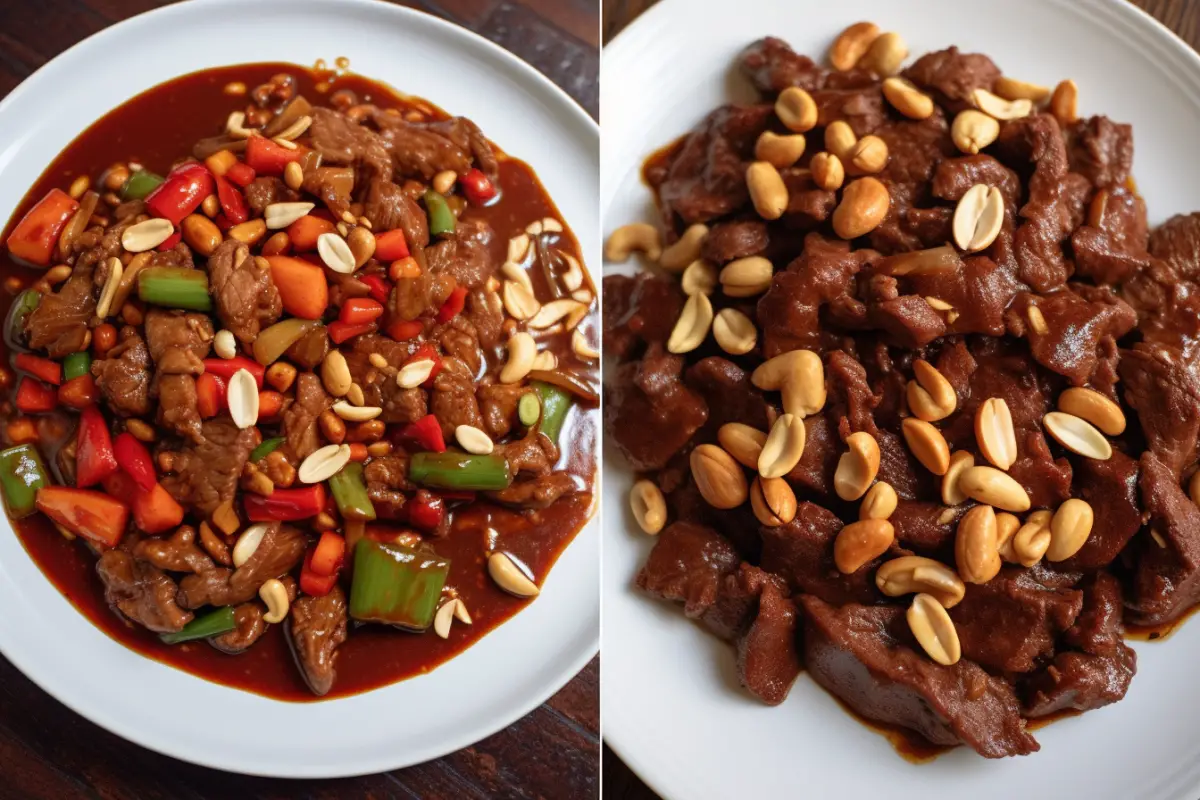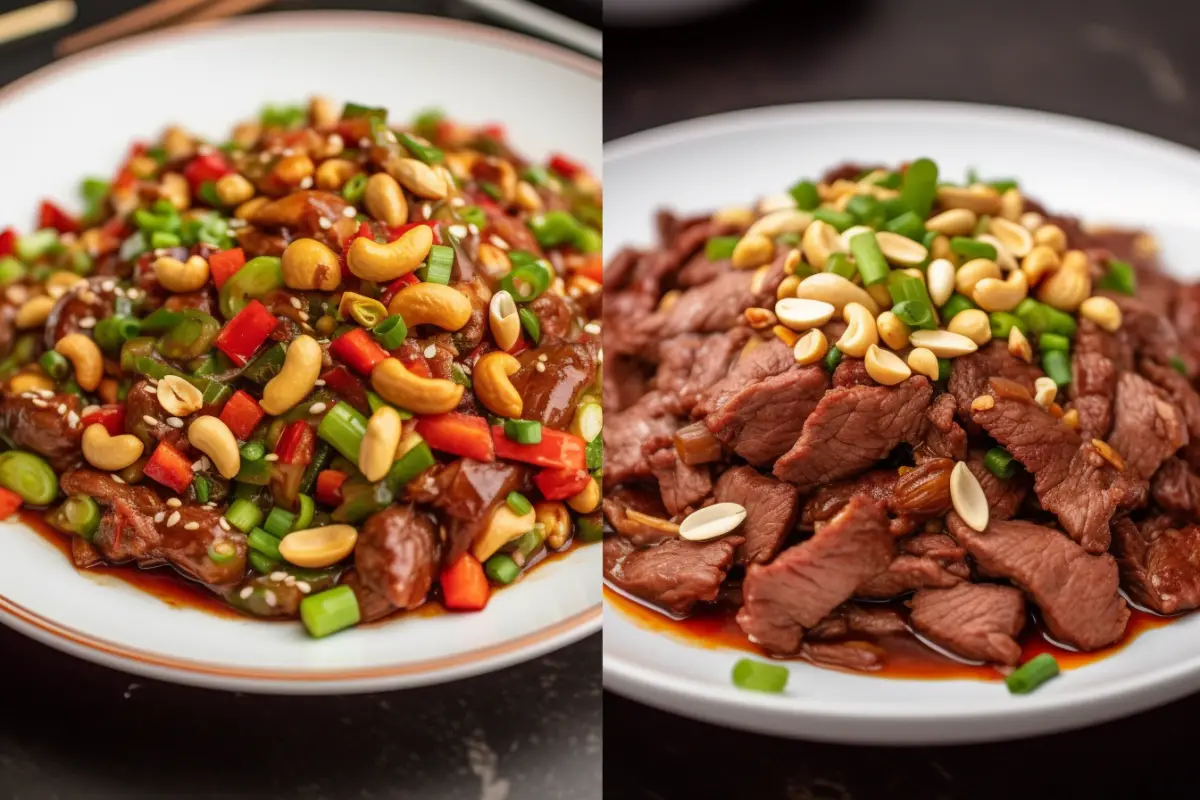If you’ve ever dined at a Chinese or Chinese-American restaurant, you’ve probably seen Kung Pao Beef and Mongolian Beef on the menu. Both dishes are incredibly popular stir-fries, yet they have distinct differences in ingredients, flavors, and origins. In this article, we’ll dive into the key differences between Kung Pao Beef and Mongolian Beef, helping you better understand and appreciate what sets these two flavorful dishes apart.
The Origins and History of Kung Pao Beef and Mongolian Beef
Kung Pao Beef’s Szechuan Roots
Kung Pao Beef comes from the Szechuan province of China, known for bold and spicy cuisine. The original dish, Kung Pao Chicken, was named after Ding Baozhen, a Qing Dynasty governor. Over time, this dish evolved, and variations like Kung Pao Beef became just as popular.
Szechuan cuisine features spicy and numbing flavors due to the use of chili peppers and Szechuan peppercorns. This combination creates the distinct flavor profile that sets Kung Pao Beef apart.
Mongolian Beef’s Chinese-American Creation
In contrast, Mongolian Beef was created in Chinese-American restaurants, despite its name. It doesn’t have traditional roots in China or Mongolia. Instead, Mongolian Beef was developed to cater to Western palates with its sweeter, milder flavor. This dish offers a sweet and savory sauce, making it a favorite in American-Chinese cuisine.
Chinese-American cuisine often adapts dishes to suit local tastes, which explains why Mongolian Beef is milder and sweeter compared to the spicier Kung Pao Beef.
The Key Ingredients in Kung Pao Beef vs. Mongolian Beef
The main differences between Kung Pao Beef and Mongolian Beef come down to the ingredients.
Main Proteins
- Kung Pao Beef: Chefs typically use flank steak or sirloin, thinly sliced, for Kung Pao Beef. These cuts are tender and absorb the marinade well, ensuring the beef stays juicy when stir-fried at high heat.
- Mongolian Beef: Similar cuts of beef, such as flank steak or sirloin, are used in Mongolian Beef. However, the focus is on creating a tender, flavorful meat that works well with the sweeter sauce.
Vegetables
- Kung Pao Beef: This dish often includes a variety of vegetables, which add both texture and flavor. The most common vegetables are:
- Bell peppers: These offer a sweet crunch that balances the heat of the dish.
- Onions: They add depth and enhance the savory quality of the beef.
- Zucchini or carrots (optional): Some variations include additional vegetables for texture and flavor.
- Mongolian Beef: Mongolian Beef uses fewer vegetables. Typically, only green onions or scallions are included, which contribute a mild, savory taste that complements the sweetness of the sauce.
Sauce Components
- Kung Pao Beef: The sauce for Kung Pao Beef is a rich blend of spicy, sweet, and tangy flavors. It includes:
- Soy sauce
- Hoisin sauce
- Rice vinegar
- Chili paste
This combination creates a sauce that balances heat, sweetness, and a slight tang. The use of chili peppers and Szechuan peppercorns adds spiciness and a unique numbing sensation.
- Mongolian Beef: The sauce for Mongolian Beef is much sweeter and less spicy than Kung Pao. It typically consists of:
- Soy sauce
- Garlic
- Sugar (often brown sugar for added depth)
This creates a sweet and savory sauce that caramelizes around the beef, resulting in a dish that is both rich and satisfying.
Flavor Profiles of Kung Pao Beef vs. Mongolian Beef
The most significant difference between Kung Pao Beef and Mongolian Beef lies in their flavor profiles.

Kung Pao Beef: Spicy, Sweet, and Tangy
Kung Pao Beef is known for its complex flavors:
- Spicy: The heat in Kung Pao Beef comes from the use of chili peppers, and sometimes Szechuan peppercorns, which create a numbing sensation.
- Sweet and Tangy: Hoisin sauce and rice vinegar add a touch of sweetness and a tangy bite, balancing the heat.
- Crunchy: Roasted peanuts, a signature ingredient in Kung Pao Beef, provide a satisfying crunch and a subtle nutty flavor that contrasts with the spiciness.
Mongolian Beef: Savory and Sweet
Mongolian Beef offers a simpler, more straightforward flavor profile:
- Sweet and Savory: The sweetness in Mongolian Beef comes from sugar or brown sugar in the sauce, creating a dish that’s primarily sweet but balanced with the saltiness of soy sauce and the savoriness of garlic.
- Mild: There is no significant heat in Mongolian Beef, making it a great choice for those who prefer milder flavors.
Cooking Techniques: Stir-Frying Kung Pao Beef vs. Mongolian Beef
Though both dishes are stir-fried, the cooking techniques vary slightly.
Marinating the Beef
- Kung Pao Beef: The beef for Kung Pao Beef is typically marinated in a combination of soy sauce, cornstarch, and sometimes egg whites. This marination tenderizes the meat and allows it to soak up the spicy flavors.
- Mongolian Beef: The marination for Mongolian Beef is simpler, often just soy sauce and cornstarch, focusing on tenderness and flavor absorption.
Stir-Frying Process
- Kung Pao Beef: Stir-frying is done at high heat, which sears the beef and ensures a crisp exterior. Vegetables like bell peppers and onions are added later to preserve their crunch.
- Mongolian Beef: The beef is also stir-fried, but the sauce is usually added earlier in the process, allowing it to thicken and coat the meat, creating a caramelized glaze.
Sauce Preparation
- Kung Pao Beef: The spicy, tangy sauce is usually cooked separately and then mixed with the beef and vegetables. The sauce remains light and coats the ingredients without overwhelming them.
- Mongolian Beef: The sauce is often caramelized with the beef during stir-frying, resulting in a thicker sauce that clings to the beef, enhancing its sweet and savory flavor.
Nutritional Differences Between Kung Pao Beef and Mongolian Beef
Both Kung Pao Beef and Mongolian Beef are flavorful dishes, but they differ in terms of nutrition.
Calories and Macronutrients
- Kung Pao Beef: Since Kung Pao Beef contains fewer sweet elements and includes vegetables like bell peppers, it tends to be lower in sugar and calories. However, the peanuts add healthy fats and extra protein.
- Mongolian Beef: Due to the higher sugar content, Mongolian Beef is often higher in calories. The use of sugar and soy sauce makes it a more carb-heavy dish, which can be less suitable for those watching their sugar intake.
Health Considerations
- Kung Pao Beef: While it contains healthy fats and protein from the peanuts, the spiciness may not be suitable for everyone.
- Mongolian Beef: Though milder, the higher sugar content means it may not be ideal for people looking to reduce sugar intake.
Popularity and Cultural Significance
Kung Pao Beef in Chinese and American Cuisine
Kung Pao Beef is highly regarded in both traditional Chinese and Chinese-American cuisine. Its spicy flavor profile appeals to those who enjoy bold, fiery dishes, and its origins in Szechuan cuisine make it a hallmark of authentic Chinese flavors. In the West, it remains popular among those seeking a spicy, flavorful stir-fry option.
Mongolian Beef in Chinese-American Cuisine
Mongolian Beef is a staple of Chinese-American cuisine, favored for its sweeter, milder flavors. It appeals to a broader audience, particularly those who prefer non-spicy dishes. Its straightforward, caramelized sauce makes it one of the most beloved options on Chinese-American takeout menus.
Serving Suggestions: What Pairs Best with Kung Pao Beef and Mongolian Beef?
Kung Pao Beef Serving Suggestions
- Rice: Serve Kung Pao Beef with steamed white rice or fried rice to balance the spiciness.
- Garnishes: Add chopped scallions, peanuts, or chili flakes to elevate the flavor and presentation.
Mongolian Beef Serving Suggestions
- Rice or Noodles: Mongolian Beef pairs well with steamed rice or lo mein noodles, which complement the sweet and savory sauce.
- Garnishes: Garnish with green onions for a mild contrast to the sweet sauce.
Variations of Kung Pao Beef and Mongolian Beef
Kung Pao Beef Variations
- Vegetarian Options: Swap out the beef for tofu or tempeh to make a vegetarian version of Kung Pao that retains its bold, spicy flavor.
- Adjusting Spice: If you prefer a milder version, reduce the chili peppers or omit the Szechuan peppercorns entirely.
Mongolian Beef Variations
- Adding Vegetables: Broccoli or carrots can be added to Mongolian Beef for extra nutrition and texture.
- Alternative Proteins: Chicken or shrimp can replace the beef for a lighter version of Mongolian Beef while maintaining the dish’s signature flavor.
FAQ Section
What is Kung Pao Beef Made Of?
Kung Pao Beef consists of sliced beef (usually flank steak or sirloin), bell peppers, onions, roasted peanuts, and a spicy, tangy sauce made with soy sauce, hoisin sauce, rice vinegar, and chili paste.
What’s the Difference Between Kung Pao and General Tso?
Kung Pao is a spicier dish with peanuts and dried chilies, whereas General Tso’s Chicken is sweeter, often deep-fried, and doesn’t include peanuts or chili peppers.
What’s the Difference Between Kung Po and Kung Pao?
Kung Po and Kung Pao refer to the same dish, but “Kung Po” is an alternative spelling, often used in British English.
Conclusion: Which Dish is Right for You?
Ultimately, your preference for Kung Pao Beef or Mongolian Beef depends on your flavor preferences. If you enjoy bold, spicy dishes, Kung Pao Beef is an excellent choice. For those who prefer sweeter, milder flavors, Mongolian Beef is likely to be more appealing. Both dishes offer a unique taste experience that makes them favorites in Chinese and Chinese-American cuisine.

